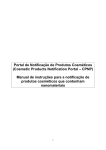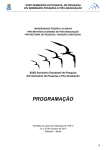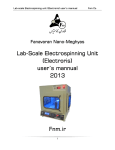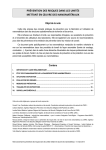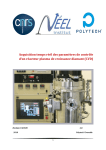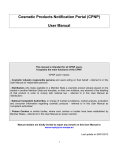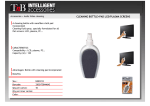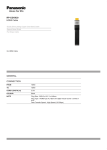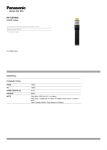Download Cosmetic Products Notification Portal (CPNP) User Manual
Transcript
Cosmetic Products Notification Portal (CPNP) User Manual for the Notification of Cosmetic Products Containing Nanomaterials 1 Table of Contents Article 16 ..................................................................................................1 1. CREATE A NOTIFICATION OF A PRODUCT CONTAINING NANOMATERIALS...................................................................................5 1.1 LOCK function ............................................................................................... 6 1.2 IDENTIFICATION .......................................................................................... 6 2. SPECIFICATION..................................................................................9 2.1 Primary particle size .................................................................................... 10 2.2 Secondary particle size ............................................................................... 10 2.3 Morphology.................................................................................................. 11 2.4 Surface characteristics ................................................................................ 12 2.5 Solubility ...................................................................................................... 12 2.6 Surface area................................................................................................ 13 2.7 Catalytic activity........................................................................................... 13 3. Quantity ..............................................................................................14 4. Toxicological profile............................................................................14 5. Safety data .........................................................................................15 6. Exposure Conditions ..........................................................................16 7. Other ..................................................................................................17 8. MY NOTIFICATIONS .........................................................................17 9. EDIT NOTIFICATIONS ......................................................................19 10. HOW TO DUPLICATE A NOTIFICATION........................................19 11. REQUEST FOR ADDITIONAL INFORMATION...............................19 12. EMAIL NOTIFICATIONS ..................................................................21 2 The Notification of Cosmetic Products Containing Nanomaterials According to Article 16 of Regualtion (EC) No. 1223/2009 Article 16 of Regulation (EC) No 1223 on cosmetic products requires that, in addition to the notification under Article 13, cosmetic products containing nanomaterials shall be notified to the Commission by the Responsible Person by electronic means six months prior to being placed on the market. The module called 'Nanomaterials' in CPNP allows for this kind of notifications. Article 16 of Regulation (EC) No 1223/2009 also establishes that the Responsible Person may designate another legal or natural person by written mandate for the notification of nanomaterials and shall inform the Commission thereof. The system therefore foresees two different roles: the Delegate and the Responsible Person (RP). When an RP mandates a Delegate, the Commission is informed through the system once each individual notification is submitted. The role of the Delegate allows entering certain data in the notification, if the RP made such a request. In the system, this means that a Delegate will initiate a notification and once he has finished entering all the information he wants/needs to enter, he will have to pass the notification on to the RP. It is then the RP who will complete the notification and notify it to the Commission. It is important to note that a Delegate can never fill out a full notification and submit it to the Commission. Certain data (like the estimated quantity of nanomaterial contained in cosmetic products intended to be placed on the market per year) always needs to be entered by the RP and only the RP can click on the button 'Notify'. The access rights of a Delegate are thus different from those of an RP. The first difference is that a Delegate will only have access to the module for Article 16 in CPNP. A Delegate will not see the menu items on the screen that are needed to notify products under Article 13 in CPNP. As mentioned above, a Delegate can also not enter the estimate of the quantity of nanomaterial contained in cosmetic products intended to be placed on the market per year. The field to enter this information is only visible to the RP. The notification of cosmetic products containing nanomaterials is mandatory for those products containing nanomaterials that have not undergone a full risk assessment by the Scientific Committee on Consumer safety (SCCS). The notification of safety information allows the Commission to request a full risk assessment in case it has concerns related to the safety of the nanomaterails for human health. This means that if the product contains nanomaterials included in such form in Annexes III, IV, V or VI to Regulation (EC) No 1223/2009, it does not need to be notified under Article 16. If a product is available in several shades, each shade containing a different nanomaterial should be notified under Article 16. If a product contains more than one nanomaterial, there should be one Article16 notification per nanomaterial. This assessment is done in different steps. That is why in the system the notification will follow certain predefined steps. The following flow charts show what these steps are. The first flow chart explains how a notification is done by an RP alone. The second flow chart shows how a notification is done by a Delegate and an RP together. The shows where there are e-mail notifications. 3 Fill out form / reply to request for extra information RP Notify to Commission / Reply to Commission Yes Check notification Commission Reply to SCCS Extra info needed? Yes No Notification ‘treated’ is stored and can still be changed to ‘Sent to SCCS’’ Concern? Yes Assess dossier SCCS Extra info needed? No Give opinion 4 Fill out form / reply to request for extra information Delegate Send to RP Complete form / complete reply to request for extra information RP Notify to Commission / Reply to Commission Yes Check notification Commission Yes Reply to SCCS Extra info needed? No Notification ‘treated’ is stored and can still be changed to ‘Sent to SCCS’’ Concern? Yes Assess dossier SCCS Extra info needed? No Give opinion 5 1. CREATE A NOTIFICATION OF A PRODUCT CONTAINING NANOMATERIALS To create a notification of a product containing a nanomaterial, the Responsible Person (or a Delegate acting on their behalf) has to click on the ‘Nanomaterials' tab and then on 'Notify a nanomaterial'. Several sections will appear on the screen. Each of them has to be completed. At the end of each section the Responsible Person has the possibility to click on: • 'Save as draft' (in case he wants to save the data, but not submit them), • 'Notify' (if the notification is complete, and he wishes to submit it to the Commission), or • 'Cancel' (in case he wants to cancel the on-going operation). It is important to note that the Delegate is not able to notify to the Commission. At the end of each section the Delegate has therefore the possibility to click on: • • • 'Save as draft' (in case he wants to save the data, but not submit them), 'Send to RP' (if the Delegate estimates that he did provide all the information), or 'Cancel' (in case he wants to cancel the on-going operation). Note: The SCCS works in English. Therefore the use of English for the information submitted into CPNP is strongly encouraged. The CPNP interface for Article 16 notifications is in English. However, to facilitate the use of the system, translations of the labels used in the interface are available under 'Useful links'. 6 1.1 LOCK function A Delegate has the possibility to lock (part of) the information he enters into a notification. The Delegate can at any moment, before sending the notification to the RP, lock (or unlock) some information. By clicking the check box the Delegate locks the following tabs: Specification, Tox. Profile and Safety Data. All the data provided in these tabs will not be visible to the RP. It is important to note that a Delegate can only lock these tabs if he provides ALL the information in these tabs. If some information in these tabs is missing, the system will prevent the Delegate from locking these tabs and sending the notification to the RP. The lock function always and only covers these three tabs (Specification, Tox. Profile and Safety Data). A Delegate can thus neither lock more nor lock less than these three tabs. The above means that the tabs 'Identification', 'Exp.Cond.' and 'Other' can never be locked and will always be visible to the RP. The lock-function is only available to the Delegates. The RP will not see this function on his screen. 1.2 IDENTIFICATION This tab contains several parts: identification of the product, identification of the nanomaterial and contact information of the Delegate/RP and their contact person. 7 1.2.1 Identification of the product The Responsible Person (or a Delegate acting on their behalf) has to, first of all, provide information on the category of the cosmetic product in which the nanomaterial will be used by selecting three category levels, starting by the level 1, subsequently followed by level 2 and 3. The choice of a category at level 1 determines the categories available at level 2; the choice of a category at level 2 will determine the categories available at level 3. All existing categories are available for consultation in Annex to this User Manual. The Responsible Person (or a Delegate acting on their behalf) has to provide the Foreseen Cosmetic Product name of the cosmetic product that will contain the nanomaterial notified. It is important to note that, if the cosmetic product is already on the market, the Responsible Person (or a Delegate acting on their behalf) has to indicate the actual name of the product, identical to the one mentioned in the notification pursuant Article 13 of Regulation (EC) No 1223/2009. It is important to note that the fields preceded by "**" are mandatory in order to create the notification as draft, while the fields indicated by "*" are mandatory in order to submit the notification. 1.2.2 Identification of the nanomaterial The Responsible Person (or a Delegate acting on their behalf) has to provide information on the identification of the nanomaterial. The IUPAC name is mandatory and other descriptors (i.e. INCI, CAS number, EINECS and/or ELINCS (EC) number, INN number, XAN number, which is the name approved by specific country (X), e.g. USAN which corresponds to the United States approved name) shall be mentioned when they 8 exist. Only when they do not exist, the Responsible Person (or a Delegate acting on their behalf) should tick the box "Not Available". The Responsible Person (or a Delegate acting on their behalf) can enter this information manually or retrieve it from Cosing database. If the user clicks on the button "Retrieve from Cosing", a pop-up page will appear and the Responsible Person (or a Delegate acting on their behalf) will be able to search for the nanomaterial into Cosing by entering at least 5 characters. A new screen will appear and display the information retrieved from Cosing. However, the Responsible Person is responsible for checking the completeness and the exactness of the information provided and correcting it where necessary. The Responsible Person or Delegate shall add information on the class of compound the nanomaterial belongs to, such as silicate, fullerene, etc., by choosing one of the options in the dropdown menu. 1.2.3 Contact details In this part of the screen the Delegate first needs to select the RP for which he is filling out the notification. This is done by clicking on the button 'Search Responsible Person'. This will open a pop-up in which the Delegate can search for the RP. He needs to enter at least three characters and then click on the 'Search' button. In the list of results, he needs to select the correct RP. The contact details of the RP will then we shown in the notification itself. The Responsible Person (or a Delegate acting on their behalf) has then to provide details of a physical contact person that may be contacted, if necessary. The Responsible Person (or a Delegate acting on their behalf) can either select an existing contact person in the drop-down list or click on '+' button to insert the details of a new physical contact person. 9 2. SPECIFICATION The User Manual for this section should be read in conjunction with the SCCS’s Guidance on the Safety Assessment of Nanomaterials in Cosmetics SCCS/1484/12 available at http://ec.europa.eu/health/scientific_committees/consumer_safety/docs/sccs_s_005.pdf The specifications of the nanomaterial including size of particles, physical and chemical properties must be provided. A full characterization of the nanomaterial at different stages of the manufacturing process as recommended by the SCCS (section 4.1 of SCCS/1484/12), taking into account all the parameters listed in Table 1 of the above mentioned Guidance should be carried out. This information should be provided, by the Responsible Person (or a Delegate acting on their behalf), under the Specification Tab, in the form of a specific pdf or Zip file. The Responsible Person or Delegate has two possibilities. The first possibility is to upload a new file containing the specifications of the nanomaterial by checking the "Upload" box. Alternatively, the Responsible Person (or a Delegate acting on their behalf) can make a reference to a previously uploaded file by clicking on "Reference". A pop-up window will show all the files on Specifications uploaded by the same Responsible Person (or Delegate acting on their behalf). The Responsible Person (or Delegate acting on their behalf) can then select the relevant file. In addition to the file containing the full characterization of the nanomaterial, the Responsible Person (or a Delegate acting on their behalf) should manually fill out in the CPNP some of the parameters for identification and characterisation listed in the SCCS Guidance (SCCS/1484/12). These data refer to 10 the raw material stage, with the exception of point 2.7 on photocatalytic activity which refers to the final formulation. 2.1 Primary particle size Information on primary particle size must be provided. The Responsible Person (or a Delegate acting on their behalf) has to provide the lowest size cut-off value, the volume weighted median, and the number weighted median, all three values expressed in nanometres (nm). For both the volume weighted and number weighted median, ranges can be indicated, corresponding to the minimum and the maximum value of the different measurements with the same method. As per the SCCS Guidance on the Safety Assessment of Nanomaterial in Cosmetics SCCS/1484/12 the particle size has to be measured with more than one method. The particle size values to be registered in the CPNP are those obtained with the method which gives the lowest particle size in terms of volume weighted or number weighted median. The results obtained with other measurement methods should be provided in the attached file, preferably in a table comparing the results obtained with the different methods used to determine particle size. The CPNP applies the English notation for numbers. Example: 0.3 and not 0,3 2.2 Secondary particle size Information on secondary particle sizes should be provided, where appropriate. The parameters requested are the minimum and the maximum volume weighted median expressed in nanometres (nm). As for the primary particle size, ranges can be provided. The CPNP applies the English notation for numbers. Example: 0.3 and not 0,3 11 2.3 Morphology Information on the physical form of the nanomaterial has to be provided. It is possible to select one among several physical forms, as it is indicated by the drop-down menu. In addition, information on the crystalline shape has to be provided. It is possible to select several crystalline shapes by ticking the corresponding boxes. NOTE: Whiskers are a type of nanofibres. Nanofiber is defined as "nanoparticle with two dimensions at the nanoscale and an aspect ratio of greater than 3:1. Types of nanofibre include: nanowhiskers, nanorods and nanowire" (ISO Publically available Specifications- PAS 71:2005). Isometric refers to a form of crystal where the unit cell is equal in all dimensions. Both under Physical Form and Crystalline Shape, when the answer is 'Other', a free text box will appear to specify what 'Other' means. It is strongly recommended to fill the box in English. 12 The Responsible Person (or a Delegate acting on their behalf) also has to indicate the agglomeration / aggregation state. It is possible to select more than one option. The aspect ratio of elongated particles should be calculated and provided. 2.4 Surface characteristics The Responsible Person (or a Delegate acting on their behalf) has to provide detailed information on nanomaterial surface characteristics. This includes information on zeta potential (measured in water or buffer), which is an indication of the strength of surface charge expressed in millivolt (mV), when it is measurable, and information on whether the nanomaterial is coated or uncoated. If the zeta potential is not measurable, the corresponding box should be checked. Any chemical/ biochemical surface modifications that could change the surface reactivity, or add a new functionality shall be indicated by selecting "Yes" or "No". 2.5 Solubility The Responsible Person (or a Delegate acting on their behalf) has to provide information on the solubility of the nanomaterial in relevant solvents, such as aqueous media and n-octanol. The solubility is expressed in milligrams per litre (mg/l). In case the solubility of the nanomaterial in aqueous media is lower than 0.01 mg/l, it must be indicated by clicking on the corresponding box. If solubility in n-octanol is not relevant, in the cases of inorganic (and not coated with organic coating) nanomaterials, this should be indicated by clicking on the corresponding box. For organic and organically coated inorganic nanomaterial for which n-octanol solubility has not been measured, it is possible to check the same box, and a justification may be provided under the tab 'Other', in the text box reserved for 'Other information'. 13 The octanol/water partition coefficient should be provided. If not applicable (e.g. inorganic, and/or not coated with an organic substance), the corresponding box should be checked. 2.6 Surface area Information on surface area should be provided. The specific surface area (SSA) and volume- specific surface area (VSSA) are mandatory for powders. For non-powder materials, both parameters are optional. The BET method measures particle surface area. Dividing the absolute surface area by the sample mass gives the so called mass-specific surface area, commonly reported in the unit square metre per gram (m²/g). It is possible to give the value as volume-specific surface area (VSSA) expressed in m²/cm³. Therefore, the calculation of the VSSA from the common result of a BET measurement requires the knowledge of the material density. 2.7 Catalytic activity The chemical reactivity of the surface of the nanomaterial should be indicated by selecting the "Yes" or "No" box. The Responsible Person (or a Delegate acting on their behalf) has to indicate whether the nanomaterial has photocatalytic activity by selecting "Yes" or "No". If it is "Yes", they will need to indicate the level of photocatalytic activity in terms of % to reference. The reference refers to the same but uncoated form of the nanomaterial. Any values above 0 should be reported. It should also be indicated if the core material is doped, by checking the "Yes" or "No" boxes. 14 NOTE: Doped nanomaterials are those that contain other intentionally introduced materials, usually for the purpose of modulating certain chemical, biochemical or catalytic reactivity. 3. Quantity An estimate of the quantity of nanomaterial contained in cosmetic product intended to be placed on the market per year must be provided by the RP. It shall be expressed in kilograms (kg). Until 10 July 2013, the Responsible Person should indicate whether the product is already placed on the market, by clicking on 'Yes' or 'No'. 4. Toxicological profile The user guide for this section should be read in conjunction with the SCCS’s Guidance on the Safety Assessment of Nanomaterials in Cosmetics SCCS/1484/12 available on http://ec.europa.eu/health/scientific_committees/consumer_safety/docs/sccs_s_005.pdf 15 The toxicological profile of the nanomaterial must be provided. The Responsible Person (or a Delegate acting on their behalf) has two possibilities. The first possibility is to upload a new file containing the toxicological profile of the nanomaterial by clicking on the button "Upload". Alternatively, the Responsible Person (or a Delegate acting on their behalf) can make a reference to an already uploaded file by checking the box "Reference". A pop-up window will show all the files on Toxicological Profile uploaded by the same Responsible Person (or Delegate acting on their behalf). The Responsible Person (or Delegate) can then select the relevant file. When the Responsible Person (or a Delegate acting on their behalf) makes reference to a file he has already uploaded, he must indicate whether the specifications are the same. In case the specifications are not the same, the Responsible Person (or a Delegate acting on their behalf) has to justify why the same toxicological profile applies to different specifications. A free text box is provided for this purpose. The use of English is strongly encouraged. Please note that the toxicological profile for the nanomaterial provided by the Responsible Person or Delegate has to fulfil the requirements established by Scientific Committee on Consumer Safety in the "Guidance on the Safety Assessment of Nanomaterials in Cosmetics" (SCCS/1484/12). The file to be uploaded, in the form of a compressed zip file, should contain: - The summary of the toxicological studies - The relevant toxicological studies mentioned in the SCCS Guidance (SCCS/1484/12), - The relevant scientific literature. 5. Safety data The safety data of the nanomaterial relating to the category of cosmetic product, as used in such products must be provided. Safety data means the Responsible Person's or Delegate's own assessment of the risk, based on the hazard identified in the toxicological profile and the exposure conditions. Here too, the Responsible Person (or a Delegate acting on their behalf) has two possibilities. The first possibility is to upload a new file containing the safety data of the nanomaterial by clicking on 'Upload'. Alternatively, the Responsible Person (or a Delegate acting on their behalf) can make a reference to an already uploaded file by clicking on 'Reference'. The reference of an uploaded file can be searched among the files containing "Safety Data" already uploaded by the same Responsible Person (or a Delegate acting on their behalf) by clicking on the button 'Search file'. 16 When the Responsible Person (or a Delegate acting on their behalf) makes reference to an already uploaded file, he must indicate if the specifications are the same. In case the specifications are not the same, the Responsible Person (or a Delegate acting on their behalf) has to explain why the same safety data apply to different specifications. The use of English is strongly encouraged. It should be noted that the safety data file provided by Responsible Person has to be in line with the criteria established by Scientific Committee on Consumer Safety in the latest "the SCCS's Notes of Guidance for the Testing of Cosmetic Ingredients and their Safety Evaluation" (SCCS/1416/12) and the "Guidance on the Safety Assessment of Nanomaterials in Cosmetics"(SCCS/1484/12). 6. Exposure Conditions In this section the Responsible Person (or a Delegate acting on their behalf) has to provide information on the exposure conditions, by indicating: - whether the product is a rinse-off or a leave-on product - the exposure route : dermal, oral and/or inhalation (in the case of spray applications) - the concentration of the nanomaterial in the product expressed in %w/w The Responsible Person has to provide all the information related to the reasonable foreseeable exposure conditions which can be included in the safety data. In addition, the Responsible Person (or a Delegate acting on their behalf) can provide further information via the following two possibilities: The first possibility is to upload a new file containing the information related to the reasonable foreseeable exposure conditions by clicking on 'upload'. In the case of deodorants, it is recommended to upload a file indicating the type of product of the listed in Table 3 of the "SCCS's Notes of Guidance for the Testing of Cosmetic Ingredients and their Safety Evaluation" (SCCS/1416/12) (deodorant nonspray; aerosol spray (ethanol based); or spray (not ethanol based)). Where there is no file uploaded, the SCCS may apply the most conservative values for exposure. Alternatively the Responsible Person (or a Delegate acting on their behalf) can make a reference to an already uploaded file by clicking on 'Reference'. A pop-up window will show all the files on Exposure Conditions uploaded by the same Responsible Person (or Delegate acting on their behalf). The Responsible Person (or Delegate) can then select the relevant file. 17 7. Other The Responsible Person (or a Delegate acting on their behalf) may indicate any other information of relevance for the safety assessment of the nanomaterial either by entering the information in the dedicated free text box or by uploading a file by clicking on 'upload'. The use of English is strongly encouraged. 8. MY NOTIFICATIONS Both the Delegate and the RP will find two lists under the menu item 'My notifications': 'New notifications' and 'Treated notifications'. The Delegate and the RP will only see the notifications that they created. The notifications that are created by the RP alone will not be visible to the Delegate. The RP and the Delegate will also not see the notifications in which they did not participate. It is the login-in use to log into the system which determines to which notification the user has access. 18 The list called 'New notifications' shows: 1. for a Delegate: • all the notifications that have the status 'Draft' and were not yet sent to the RP. • all the notifications for which the Commission or the SCCS made a request for additional information and the Delegate did not yet reply. 2. for a RP: • • all the notifications that have the status 'Draft' and were not yet notified to the Commission. all the notifications for which the Commission or the SCCS did make a request for additional information and for which the Delegate did already formulate a reply but the RP did not yet reply. The list called 'Treated notifications' shows all the notifications that are notified and for which there is no request for additional information or a reply was already given to such a request. These two lists also give the user the possibility to follow the status of each notification to which he has access. The status of each notification is updated automatically in these lists. The status of a notification is identified by a name and a colour: 1. Draft by Delegate 2. Draft by RP 3. Notified 4. Additional info requested by EC to Delegate 5. Additional info requested by EC to RP 6. Final reply to EC request 7. Notification treated 8. Sent to SCCS 9. Additional info requested by SCCS to Delegate 10. Additional info requested by SCCS to RP 11. Final reply to SCCS request 12. Opinion given by SCCS 13. Deadline Expired Note that the status 'Notification Treated' does not mean that no concern may arise regarding the safety of the nanomaterial and it can be changed into 'Sent to SCCS' at any time. In addition, the status 'Notification Treated' does not mean that the product can be placed on the market before the expiration of the six-month standstill. 19 9. EDIT NOTIFICATIONS All notifications that have the status 'Draft' can still be edited. It is important to note that once a notification is notified to the Commission it can no longer be edited. To edit a notification, the following has to be done: 1. go to 'My nanomaterials' 2. in the list of 'New notifications' find the notification that needs to be edited 3. click on the 'Edit' button and the notification will open 4. edit all the information that needs to be changed or completed 5. either save as draft or click the 'Send to RP' button (for a Delegate) or the 'Notify' button (for an RP). Note that an RP can always edit the data entered by a Delegate, if this Delegate did not lock his information. All information that is locked by a Delegate is not visible to the RP and can thus not be edited by the RP. 10. HOW TO DUPLICATE A NOTIFICATION The 'Duplicate' function allows a user to copy all the information (except for the Foreseen Cosmetic Product Name) from a 'notified' notification to a new notification. The information that is copied into the new notification can be edited. It is important to note that this duplicate-function is linked to the lock-function described above. There are different scenarios. 1. A Delegate fills out a notification and does not use the lock-function. The RP will be able to duplicate this notification (after notifying). All the information is copied in this new notification, including the contact details of the Delegate. When the RP clicks the 'Notify' button for this new notification, the Delegate will receive an e-mail notification. The Delegate did not participate in the creation of this new notification, but given that his information is being reused, it is necessary that he is aware of this. This also means that, if the Commission or the SCCS make a request for additional information concerning this second notification, this request will first be sent to the Delegate. 2. A Delegate fills out a notification and uses the lock-function. After the information is notified to the Commission, the RP will not be able to duplicate this notification. The fact that the RP cannot see part of the information prevents him from being able to duplicate. In this case only the Delegate can duplicate the notification, and he will have to pass on the draft notification to the RP when he is finished filling out his part. 11. REQUEST FOR ADDITIONAL INFORMATION Both the Commission and the SCCS have the possibility to make a request for additional information. This functionality can only be used once by each of them. There are two possible scenarios: 1. There is a Delegate. The request will be sent to the Delegate first. He needs to give his information and then sent the notification to the RP so that the RP can also give his reply to the request for additional information. It is important to note that if a request for additional information only concerns the 'Quantity' tab, the request will only go the RP (the Delegate does not have access to this tab). 2. There is no Delegate. The request is only sent to the RP. The RP needs to give his reply and send this reply to the Commission or the SCCS. 20 Both the Commission and the SCCS need to clearly formulate their request. They also need to indicate the tab or tabs in which some information needs to be added by checking the relevant box(es). It is important to note that only the tabs that were indicated will be accessible to the Delegate and the RP. When the Delegate and the RP will receive the request for additional information, they will find the following information in the tab 'Need info': • • • who formulated the request, which tabs were selected, and the request. How to reply to a request for additional information? The Delegate/RP will have access to the tabs that were selected by either the Commission or the SCCS. In these tabs the Delegate/RP can edit any information. All the fields are editable. Also at the bottom part of each accessible tab the Delegate/RP can upload a document and there is also a free text box to formulate a reply to the request. The use of English is strongly encouraged. 21 If the Delegate/RP uploads a document, this document will not replace the previously uploaded documents. It will be stored in the notification with all the other documents that were already uploaded into the notification. 12. EMAIL NOTIFICATIONS The system will at certain moments in time sent e-mail notifications to the Delegate and to the RP. These e-mail notifications will let the Delegate/RP know that the status of the notification changed. The e-mail notifications are sent when: When is e-mail notification sent Who receives e-mail notification 1. Delegate sends filled out notification to RP 2. RP notifies to the Commission 3. RP deletes the draft notification made by the Delegate 4. The Commission makes a request for additional information 5. Delegate sends his reply to the EC request to the RP 6. RP sends his final reply to the EC request 7. The Commission decides there is a concern and sends the notification to the SCCS 8. The SCCS makes a request for additional information 9. Delegate sends his reply to the SCCS request to the RP 10. RP sends his final reply to the SCCS request 11. The SCCS has formulated an opinion 12. The deadline has expired Delegate and RP Delegate, RP and Commission Delegate and RP Delegate, RP and Commission Delegate and RP Delegate, RP and Commission Delegate, RP and Commission and SCCS Delegate, RP, Commission and SCCS Delegate and RP Delegate, RP, Commission and SCCS Delegate, RP, Commission and SCCS Delegate, RP, Commission and SCCS Note that, when an e-mail notification is sent to a Delegate and to a RP, the same e-mail is also sent to the contact persons (of both the Delegate and the RP) whose the contact details were included in the notification. 22






















